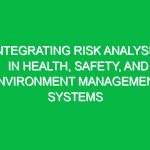Introduction to Risk Assessment in HSE
Risk assessment is a systematic process aimed at identifying, evaluating, and prioritizing risks associated with health, safety, and environmental (HSE) management. Its relevance cannot be overstated; it serves as the foundation for creating safer workplaces and ensuring compliance with regulatory standards. In an era where organizations are increasingly held accountable for their operational impacts on health and safety, understanding risk assessment is vital for any entity aiming to mitigate potential hazards.
Imagine a construction site bustling with activity. Workers are operating heavy machinery, and scaffolding towers precariously high above the ground. Without a thorough risk assessment, the likelihood of accidents escalates dramatically. This scenario highlights not only the importance of identifying hazards but also the critical need for implementing appropriate safety measures.
Identifying Hazards and Risks in HSE Management
To effectively conduct a risk assessment, one must first identify the myriad of potential hazards present in any given environment. Hazards can be physical, chemical, biological, ergonomic, or psychosocial.
1. Physical Hazards
Physical hazards are perhaps the most recognizable risks. Consider the presence of machinery on a manufacturing floor. Equipment such as conveyor belts, cranes, and forklifts can pose significant dangers if not properly managed. A real-world example is the case of a worker who lost a finger while trying to clear a jammed conveyor belt. This incident underscores the need for comprehensive training and clear safety protocols.
2. Chemical Hazards
Chemical hazards arise from exposure to harmful substances. Industries such as agriculture and manufacturing often handle chemicals that can cause respiratory issues, skin irritations, or even long-term health effects. For instance, a factory mishap involving the accidental release of toxic gas can endanger not only workers but also nearby communities.
3. Biological Hazards
Biological hazards include bacteria, viruses, and other pathogens that can lead to illnesses. In healthcare settings, for instance, the risk of exposure to bloodborne pathogens is significant. During a pandemic, understanding and managing these risks become even more critical as organizations strive to protect their employees and the public.
4. Ergonomic Hazards
Ergonomic hazards are often overlooked, yet they play a crucial role in workplace safety. Poorly designed workstations can lead to musculoskeletal disorders. For example, an office worker may develop chronic back pain due to inadequate seating arrangements and prolonged periods of sitting.
5. Psychosocial Hazards
Finally, psychosocial hazards encompass stress, workplace harassment, and other mental health concerns. A study by the World Health Organization (WHO) indicated that work-related stress leads to significant health impacts, including anxiety and depression. Organizations must be aware of these risks and take proactive measures to foster a supportive work environment.
Conducting a Risk Assessment
Once hazards have been identified, the next step is to conduct a thorough risk assessment. This process involves several key stages:
1. Risk Identification
In this phase, organizations must systematically identify all potential risks associated with the identified hazards. This might involve gathering input from employees, reviewing past incident reports, and conducting site inspections.
2. Risk Analysis
Following identification, the next step is risk analysis. This involves assessing the likelihood of each risk occurring and the potential severity of its impact. For example, the risk of a chemical spill in a manufacturing plant may be classified as high likelihood with severe consequences, necessitating immediate attention.
3. Risk Evaluation
In this stage, organizations prioritize risks based on their analysis. Risks deemed unacceptable must be addressed promptly. For instance, a situation where a worker is exposed to hazardous chemicals without appropriate protective gear would rank high on the evaluation scale.
4. Risk Control
The implementation of control measures is the next crucial step. This may include engineering controls, administrative policies, and personal protective equipment (PPE). In the earlier example of the manufacturing plant, effective control might involve installing ventilation systems and providing proper PPE to workers.
5. Monitoring and Review
After implementing control measures, continuous monitoring and review are essential. This ensures that the measures remain effective and that any new hazards are promptly addressed. Regular safety audits and employee feedback can help refine risk management strategies.
Best Practices for Risk Assessment
To optimize risk assessment in HSE management, organizations can adopt several best practices:
1. Engage Employees
Employee involvement is vital. Workers are often the best source of information regarding potential hazards. By facilitating open communication and encouraging reporting of near-misses, organizations can foster a culture of safety.
2. Training and Education
Regular training on safety protocols and risk management is essential. Employees should be well-versed in how to identify hazards and respond appropriately. For example, a fire drill not only prepares employees for emergencies but also reinforces the importance of safety procedures.
3. Utilize Technology
Leveraging technology can enhance risk assessment processes. Software tools designed for HSE management can streamline data collection and analysis, making it easier to identify trends and areas for improvement.
4. Conduct Regular Audits
Regular safety audits help ensure compliance with established protocols. These audits can also uncover hidden risks that may have been overlooked during previous assessments.
Regulations and Standards Governing Risk Assessment
Risk assessment in HSE management is governed by various regulations and standards. Understanding these is crucial for compliance and effective risk management.
1. Occupational Safety and Health Administration (OSHA)
In the United States, OSHA sets forth regulations requiring employers to conduct hazard assessments. The goal is to protect workers from potential dangers in the workplace.
2. ISO 45001
ISO 45001 is an international standard for occupational health and safety management systems. It emphasizes a proactive approach to risk assessment and management.
3. Environmental Protection Agency (EPA)
For environmental risks, the EPA provides guidelines on conducting environmental assessments. Organizations must understand their obligations to mitigate any adverse environmental impacts.
Conclusion
In conclusion, effective risk assessment is paramount in the realm of Health, Safety, and Environment management. By identifying potential hazards, analyzing risks, and implementing robust safety measures, organizations can create safer workplaces and protect their employees. Continuous monitoring and adherence to regulatory standards further enhance these efforts.
As we navigate an increasingly complex world, understanding the intricacies of risk assessment will empower organizations to not only comply with regulations but also cultivate a culture of safety that benefits everyone involved. It’s not just about avoiding penalties; it’s about fostering a safe and healthy work environment for all.


